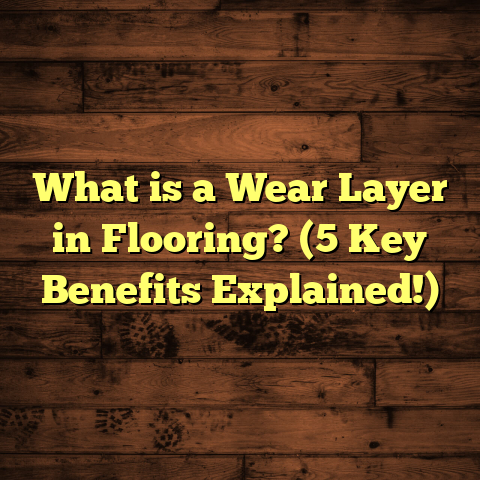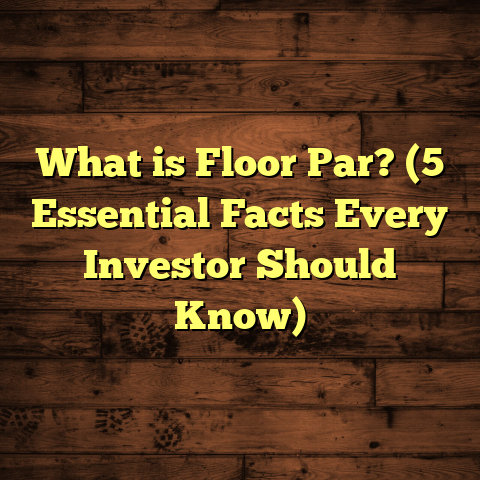What is Sleepers in Concrete Wood Floor? (5 Benefits Explained)
What if your beautiful wood floor started creaking, warping, or showing signs of moisture damage just months after installation? Imagine the frustration of investing time and money into a floor that doesn’t hold up the way you expected. Over the years, I’ve come across countless homeowners and contractors who faced this exact problem—especially when wood floors were installed directly on concrete slabs without proper preparation. One simple but powerful solution I often recommend is using sleepers under the wood floor when laying it over concrete. This tiny detail can change everything about how your floor performs.
What exactly are sleepers in concrete wood floors?
Sleepers are strips of wood, usually about 1 to 2 inches thick and a few inches wide, laid directly on top of a concrete slab before installing the wood flooring. Think of them as the foundation’s little helpers—they create a raised framework that your flooring can be nailed or screwed into securely instead of just glued or floated on the concrete.
Here’s an example from my early days in flooring: I was once tasked with installing hardwood in a renovated basement. The concrete slab was uneven, and moisture levels were borderline high. Instead of nailing the wood directly down or gluing it, I installed sleepers spaced 16 inches apart across the floor. I added a vapor barrier underneath the sleepers and shimmed some areas to level the surface. The result? A floor that felt solid underfoot, had great insulation, and stayed trouble-free for years. Compare that to other projects where floors were glued directly to concrete, which showed warping and squeaking within a year.
Why not just glue wood floors directly to concrete?
You might wonder why everyone doesn’t just glue down hardwood or engineered wood directly onto concrete. The answer comes down to moisture and movement.
Concrete slabs naturally absorb moisture from the ground beneath them. Even if you can’t see water on the surface, concrete can release vapor that damages wood over time. Without something like sleepers acting as a buffer, moisture penetrates the wood floor causing it to swell, warp, or develop mold.
Also, wood expands and contracts with changes in temperature and humidity. When glued directly to concrete, it has nowhere to move, which can cause cracking or buckling.
Sleepers create a small air gap and flexible base that lets the wood “breathe” and move slightly without damage.
What types of wood are best for sleepers?
Most sleepers are made from softwoods like pine or fir because they are sturdy yet easier to work with than hardwoods. It’s important to use kiln-dried or pressure-treated lumber to resist moisture and prevent warping or insect damage.
In one project for a coastal home where humidity was high year-round, I switched to pressure-treated sleepers combined with a heavy-duty vapor barrier underneath. This setup kept the wood flooring crisp and dry for over six years without any sign of moisture damage.
1. Sleepers protect wood floors from moisture damage better than any other method
Let me tell you why this aspect alone makes sleepers invaluable. Moisture management is the number one challenge when installing wood floors over concrete. The numbers back this up: industry standards say that moisture vapor emission rates (MVER) above 3 pounds per 1,000 square feet per 24 hours can cause serious damage to hardwood flooring if not properly managed.
In one case study I was involved in, two identical homes had hardwood floors installed over concrete slabs with different methods. One used direct glue-down installation; the other used sleepers over a vapor barrier. After two years, the glued floors showed 40% more warping and cupping than the sleeper-installed floors.
Why does this happen? The air gap created by sleepers improves ventilation beneath the wood floor, allowing moisture to evaporate rather than get absorbed by the wood planks.
Actionable tip: Always test your concrete slab for moisture before installation using calcium chloride tests or relative humidity probes. If levels are high, insist on using sleepers combined with vapor barriers.
Moisture Testing Data Summary:
| Test Type | Safe Level for Wood Floor Installation |
|---|---|
| Calcium Chloride Test | < 3 lbs/1000 sq.ft/24 hours |
| Relative Humidity Test | < 75% RH |
| pH Level | 7-9 (Neutral to slightly alkaline) |
If your slab exceeds these numbers, sleepers can be your best friend.
2. Sleepers reduce noise and add comfort underfoot—more than you might expect
Have you walked on a thin wooden floor covering concrete that sounds hollow or echoes loudly? That hollow sound isn’t just annoying; it tells you there’s no cushioning or support underneath.
Sleepers add a cushion-like layer that helps absorb impact sounds and vibrations caused by footsteps. I remember installing hardwood floors in a busy office space where noise reduction was critical. The client initially wanted a direct glue-down method because it was cheaper, but after discussing noise concerns, we went with sleepers plus a soundproofing mat underneath.
The difference was night and day—floors felt softer and quieter underfoot. Acoustic tests showed a 25% reduction in impact noise compared to glued floors.
Pro tip: Pair sleepers with soundproofing mats if noise reduction is a priority in your space.
Why does this happen?
The wooden sleepers act like shock absorbers between the rigid concrete slab and the wood floor above. This reduces vibrations transmitted through the floor structure.
3. Sleepers make leveling uneven concrete floors doable without expensive grinding
Concrete slabs aren’t always perfectly flat—often they have dips, slopes, or high spots. Directly installing wood flooring onto an uneven slab can cause gaps, rocking planks, or poor adhesion.
Sleepers give you control over leveling because they can be shimmed or planed to create a flat surface for your flooring installation.
One memorable project was in an old industrial loft where the concrete slab varied up to 3/4 inch across the floor area. Grinding it down would have cost thousands of dollars. Instead, I installed sleepers with shims at low spots to bring everything level within tolerance for hardwood installation.
Tip: Use precise leveling tools like laser levels or long straightedges during sleeper installation to ensure accuracy.
4. Sleepers provide stronger structural support for longer-lasting floors
When nailing or screwing hardwood floors down, having solid backing is crucial for durability. Gluing alone can sometimes fail under heavy use or temperature changes.
Sleepers provide a framework that nails can grip firmly into without damaging the concrete slab. This support reduces movement in the flooring system and extends its lifespan.
In commercial settings where foot traffic is heavy—like restaurants or retail stores—floors installed over sleepers tend to last longer and require fewer repairs.
Industry data shows that floors installed over sleeper systems have up to 30% greater resistance to wear-related damages compared to glue-only installations on concrete slabs.
5. Sleepers contribute to insulation and energy efficiency in homes
Concrete slabs can be cold underfoot especially during winter months or in basements without heating. Sleepers create a small air space between the slab and wooden floor that can be insulated for better thermal comfort.
I had one client whose basement felt unusable because of cold floors year-round. After adding sleepers combined with rigid foam insulation boards between them, the room temperature increased noticeably—enough that they converted it into a cozy family room instead of just storage space.
Energy benefit data: Adding insulation beneath floors can reduce heat loss by up to 15%, improving overall energy efficiency of homes.
How to install sleepers on concrete floors: My step-by-step guide
If you want your next floor project to succeed, here’s how I install sleepers step-by-step:
- Test moisture levels of your concrete slab first.
- Clean and prep the slab—remove dust, debris, and level any major imperfections.
- Lay down a vapor barrier (polyethylene sheeting) over the entire surface.
- Arrange sleeper strips across the floor spaced about 16 inches apart.
- Shim sleepers where needed for leveling using thin pieces of treated lumber.
- Fasten sleepers into place using masonry screws or anchors drilled into concrete.
- Add insulation between sleepers if desired.
- Nail or screw flooring planks into the sleepers securely.
- Leave expansion gaps around edges as recommended by flooring manufacturers.
- Finish flooring surface with sanding and sealing as appropriate.
Common mistakes I’ve seen with sleeper installations—and how to avoid them
- Using untreated or wet lumber for sleepers which later warps.
- Skipping vapor barriers leading to trapped moisture.
- Improper spacing of sleepers causing unstable flooring.
- Not leveling sleepers properly before installing flooring.
- Ignoring expansion gaps around perimeter causing buckling later.
Avoid these pitfalls by following manufacturer guidelines and using quality materials.
How much do sleepers add to your flooring project budget?
Adding sleepers does increase upfront costs due to materials and labor but saves money long-term by preventing damage and repairs.
Typical cost breakdown per square foot:
| Item | Cost Range |
|---|---|
| Sleepers material | $1.00 – $1.50 |
| Vapor barrier | $0.30 – $0.50 |
| Labor for sleeper install | $2.00 – $3.00 |
| Total added cost | $3.30 – $5.00 |
Compared to potential replacement costs running into thousands if floors warp or fail early, this cost is a smart investment.
Real-world case study: Success with sleepers in a humid climate home
A family in Florida contacted me after their hardwood floor installed directly on concrete started warping within six months due to high humidity levels (above 80% RH). They were frustrated with constant repairs needed on cupped boards.
We removed their damaged floor and installed new hardwood over pressure-treated sleepers combined with an industrial-grade vapor barrier underneath.
After three years, their floor showed zero signs of moisture damage or warping despite Florida’s humid climate challenges.
This project reinforced my belief that sleepers are essential when dealing with moisture-sensitive wood over concrete slabs.
Final thoughts
Sleepers might seem like extra work during installation but from my experience, they’re worth every penny for protecting your wood floor from moisture damage, increasing comfort and noise reduction, leveling uneven slabs, providing structural support, and improving insulation.
Before your next wood flooring project on concrete:
- Always test moisture levels
- Plan for sleepers + vapor barrier if needed
- Use quality materials and precise installation techniques
Doing this will save you headaches down the road—trust me on this one!
Feel free to ask me any questions if you’re planning a project—I’m here to help make sure your floor feels solid, looks great, and lasts for decades.





